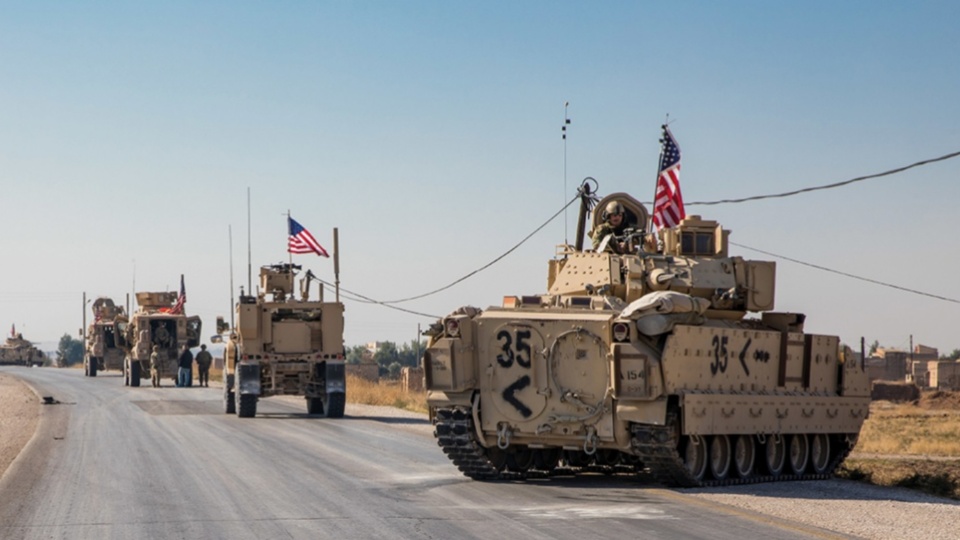
“It never happened. Nothing ever happened. Even while it was happening it wasn’t happening. It didn’t matter. It was of no interest. The crimes of the United States have been systematic, constant, vicious, remorseless, but very few people have actually talked about them.”
Sadly, Harold Pinter’s Nobel Prize for Literature lecture continues to be as relevant today as when he gave it in 2005.
And nothing confirms the accuracy of the British playwright’s incisive words better than the ongoing U.S. intervention in Syria.
“Do you think the presence of the U.S. military in Syria is illegal?” Chinese reporter Edward Xu asked Faran Haq, deputy spokesperson for the U.N. secretary-general, during a March press conference.
Haq’s jaw-dropping reply? “There’s no U.S. armed forces inside of Syria… I believe there’s military activity. But, in terms of a ground presence in Syria, I’m not aware of that.”
Back in the real world, U.S. troops have been on the ground in Syria since 2015.
In a 2017 briefing with journalists, U.S. Army Major General James B. Jarrad, who was the then head of the U.S.-led special operations taskforce in Syria and Iraq, let slip there were 4,000 U.S. troops in Syria, before backtracking.
Today, most reports estimate the number of U.S. troops at around 900, though in March the Associated Press noted there was also “an undisclosed number of contractors” and U.S. special forces who are not included in the official count.
Part of the confusion is likely because senior U.S. officials deliberately misled the Donald Trump administration—which was keen to withdraw troops—on the size of the U.S. military footprint in Syria.
“We were always playing shell games to not make clear to our leadership how many troops we had there,” James Jeffrey explained in an interview with the Defense One website in 2020 after he had stepped down as U.S. Special Representative for Syria Engagement.
Whatever the true number is, in 2018, New Yorker magazine reported there were 12 U.S. bases in Syria, including four airfields—all in the east of the country.
Speaking in May 2022, Joshua Landis, professor of Middle Eastern studies at the University of Oklahoma, explained the U.S., working with the Syrian Democratic Forces (SDF), controls around 25% of Syria—an area about the size of Croatia, the New Yorker estimated.
There have been occasional attacks on the U.S. forces there, too. In January 2019, four U.S. personnel were killed, and in March this year, a drone attack on a U.S. base killed one U.S. contractor and wounded seven U.S. troops.
Other than reports of assassinations of high-level ISIS leaders, there seems to have been no serious independent investigation into the impact the U.S. troops are having on the local population while in Syria.
Why are U.S. forces on the ground?
An April Agence France-Presse report printed in The Guardian repeated the U.S. government’s initial justification, noting: “U.S. troops remain in Syria… as part of a U.S.-led coalition battling the remnants of [ISIS], which remains active in Syria and neighboring Iraq.”
However, with the military campaign against ISIS “nearly completed,” in September 2018, the Washington Post noted the U.S. government “had redefined its goals” in Syria.
These now included “the exit of all Iranian military and proxy forces from Syria, and establishment of a stable, non-threatening government acceptable to all Syrians and the international community.”
Trump himself suggested another reason for the U.S. occupation of Syria.
“We are leaving soldiers to secure the oil,” he stated in 2019. “And we may have to fight for the oil. It’s OK. Maybe somebody else wants the oil, in which case they have a hell of a fight. But there’s massive amounts of oil.”
Some analysts question whether this is correct, though the respected energy expert Daniel Yergin did explain oil “was very important to the Assad regime before the civil war because it produced 25% of the total government revenues.”
According to a March 2018 New York Times report, the U.S. forces control most of Syria’s oil wealth, with influential Republican Sen. Lindsey Graham arguing that by continuing “to maintain control of the oil fields in Syria, we will deny Assad and Iran a monetary windfall.”
Of course, this also gives the U.S. significant leverage with the Syrian government and its international supporters moving forward.
Furthermore, Western media reports rarely consider whether the U.S. occupation is legal, even though their presence is opposed by the Syrian government and not authorized by the U.N.
Like the U.S.-Britain-enabled mass slaughter in Yemen, the U.S. occupation of Syria is hiding in plain sight.
There are news reports published in the mainstream media about the U.S. intervention in Syria, but there has never been the kind of sustained, searching front-page coverage the issue deserves.
As Edward Herman and Noam Chomsky argued in 1988’s ground-breaking work on the political economy of the mass media, Manufacturing Consent, “Just because a careful reader looking for a fact can sometimes find it with diligence and a skeptical eye tells us nothing about whether that fact received the attention and context it deserved, whether it was intelligible to the reader or effectively distorted or suppressed.”
A similar U.S.-British government-friendly amnesia courses through the broader coverage and discussion of the Western involvement in the Syrian war.
In February 2017, Dr. Jamie Allinson, a senior lecturer in politics and international relations at the University of Edinburgh, argued it is a myth that “the U.S. has pursued a policy of regime change to topple the Ba’athist Assad regime.”
The Middle East specialist went on to make the extraordinary claim that “the amount of weaponry and ammunition actually supplied by the U.S. has been highly limited and the precondition of its supply was that it be used against ISIS rather than Assad.”
Similarly, two years earlier a Guardian editorial referred to the West’s “refusal to intervene against Bashar al-Assad,” while in 2016 Paul Mason, then at Britain’s Channel 4, blindly asserted the U.S. had “stood aloof from the Syrian conflict.”
Contrast these claims with statements from key figures in the U.S. government and mainstream press reports.
“Washington did provide aid on a large scale to Syrian armed opposition,” Steven Simon, the senior director for the Middle East and North Africa at the U.S. National Security Council during the Obama administration, explained in 2018.
While the Pentagon ran a program to train rebels to fight ISIS, according to a January 2016 New York Times report, the CIA ran a separate, larger program “which focuses on rebel groups fighting the Syrian military.”
According to reports in the New York Times, the U.S. has been involved in helping to send arms to the Syrian opposition forces since at least mid-2012.
Citing U.S. officials, in June 2015 the Washington Post revealed: “The CIA has trained and equipped nearly 10,000 fighters sent into Syria over the past several years,” spending $1.2 billion a year, making it “one the agency’s largest covert operations.”
Robert Malley, the White House coordinator on the Middle East, North Africa, and the Gulf Region in the Obama administration, made the obvious point to the Real News Network the same year: “We became part of the regime change—by definition, even if we denied it—once we’re supplying the armed opposition which had only one goal… which was to topple the regime.”
U.S. Secretary of State John Kerry was even clearer in September 2013: “President Obama’s policy is that Assad must go.”
No doubt the U.S. government is very happy with the media and academic-fueled memory-holing of U.S. intervention in Syria and beyond.
After all, it creates an unscrutinized political space for the U.S. and its allies, including Britain, to project military and political power with minimal pushback from the general public and civil society.
And while the officials, journalists, and academics that have got U.S. intervention in Syria so wrong usually end up “failing upwards,” those on the business end of the Western military machine aren’t so lucky.
Morning Star
We hope you appreciated this article. At People’s World, we believe news and information should be free and accessible to all, but we need your help. Our journalism is free of corporate influence and paywalls because we are totally reader-supported. Only you, our readers and supporters, make this possible. If you enjoy reading People’s World and the stories we bring you, please support our work by donating or becoming a monthly sustainer today. Thank you!










